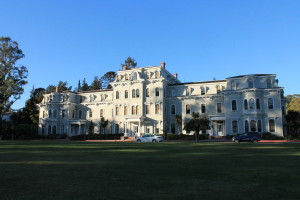
A sculpture rests on the stark white walls of the Mills College Art Museum (MCAM). Multicolored drips crawl down the piece. The audio from the video viewing room fades in and out, mingling with the sounds of footsteps.
From Jan. 18 to March 12, the MCAM will host Diana Al-Hadid and Elena Dorfman’s work in the main gallery. On assignment with the United Nations High Commissioner for Refugees, Dorfman’s work focuses on teenagers affected by the Syrian Conflict, shown through photographs and a video. Al-Hadid is Syrian-born, but Ohio-raised, and works in sculpture and large-scale pieces.
“Some people have seen or interpreted Islamic or Middle Eastern patterning in [Al-Hadid’s] work,” Jayna Swartzman-Brosky, MCAM program director, said. “Once an artist’s work leaves its studio, it is open to interpretation.”
The exhibit is a traveling show, and arrived at Mills from Tulane University in New Orleans, Louisiana, where the art was originally curated. While the exhibit comes at a very topical moment, considering the current political climate, Stephanie Hanor, the director of the MCAM, says the relevancy and timing was unplanned.
“We’ve been thinking about them and knowing they’ve been coming for a year,” Hanor said. “We had no idea how relevant it would be.”
Although their work is very different in mediums, focus and style, the two artists have been combined in this exhibit.
“Each of them requires different mediums to tell different stories,” Jayna Swartzman-Brosky, MCAM program director said.

Much of Al-Hadid’s work is abstract, repeating the use of dripping imagery, whether in bronze and stainless steel sculpture or wall art made of gypsum, plaster and other materials. There are seven pieces, five wall structures and two sculptures. All use the drip imagery, to a sometimes obscuring effect. Swartzman-Brosky’s favorite piece, The Seventh Month, seems to have a faint image of a woman, possibly the Virgin Mary.
“I really like the 7 month piece, because I think Mary’s holding a sword in it, and she’s 7 months pregnant,” Swartzman-Brosky said. “[Its beauty] can’t be erased.”
Hanor’s favorite piece is also from Al-Hadid, a sculpture piece called Head in the Clouds. However, both Swartzman-Brosky and Hanor agree that Dorfman’s work is still incredibly moving.
“It’s just a very lonely and resigned photograph,” Swartzman-Brosky said of a photograph called Dvaa. “It conveys a feeling of being lost or unsettled.”
The topical nature of the show makes it even more impactful, art and technology major Laura Elizarras said.
“This is one of the prime times when art can be a tool to educate people on the realities of the world,” Elizarras said.
The MCAM is open Tuesday through Sunday. More information about hours and the exhibit are available on MCAM’s website.



